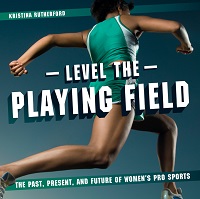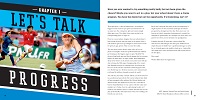| ________________
CM . . .
. Volume XXIII Number . . . .February 17, 2017
While women have broken the glass ceiling in many areas of society, this timely book asks the question: “Why is the pro sports experience so different for a man versus a woman?” Why do such obvious barriers still exist to impede the advancement of professional female athletes? What can be done to make change towards a more equal representation of women in sports?
Rutherford clearly explains how factors from the past have fuelled societal change, and she provides examples of individual athletes who have been able to achieve success despite challenges. Even though it is clear that there is still much to accomplish, the focus remains optimistic as the book recaps forward strides and describes which issues still need to be addressed. Each of the five chapters presents a different aspect of the inequality in professional sports, effectively building an overall understanding of the topic for young researchers. The opening chapter, “Let’s Talk Progress” cites the lack of opportunities available for female athletes as one of the main reasons for the discrepancy between men and women’s sports. It traces gains made towards greater acceptance, such as the implementation of the United States Title IX law that demanded equal gender rights in sports at the school and college levels. Billie Jean King’s fight for equal pay on the pro tennis tour is presented as one example of how attitudes towards female athletes have been confronted and advanced in the past. “Women of Power” is an inspiring account of the changing stereotypes of the definition of the female athlete, although it recognizes that, when it comes to physical appearance, double standards are still sometimes evidenced. The accomplishments of women from a wide variety of sports are showcased: Mixed Martial Arts athlete Miesha Tate, IndyCar driver Danica Patrick, Brazilian soccer star Mata Vierira da Silva, and tennis star Serena Williams. While there have been advances in regard to ‘levelling the playing field’, the next section, “Money, Money, Money”, shows that there are huge salary differences between the sexes. Interviews with several professionals make it clear that, in order to make a living in sports today, most female athletes must explore a wide variety of creative options, such as playing in other leagues during the off-season or searching out sponsorship deals – a salary is simply not enough.
“Led by the Stars” describes the cyclical effect of media promotion of women in sports and its impact in inspiring greater participation by young girls and women. An interview with South Korean golfer Inbee Park demonstrates the positive effect of role models. The United States win of the 1999 World Cup is also credited as having a major worldwide influence on increasing the profile of women’s soccer. The final chapter, “The Future”, acknowledges the ongoing discrimination of women in various countries when it comes to basic rights and participation in sports. It also gives examples of other areas of the sports world where women are forging new inroads as capable coaches, general managers, marketing directors, union representatives, and sports operations managers.
Level the Playing Field has a highly readable writing style yet provides comprehensive coverage and enough facts to serve as a worthy reference source. Engaging colour sports action photos and an attractive page layout interspersed with informative sidebars should spark further investigation by student researchers of both genders. A table of contents, index, and a list of citation sources – many of which include URL links – all contribute to the title’s usefulness. Although the greatest gains for women in sports have been made in the United States, an attempt has been made to include references to athletes from a number of different countries. A small photo of Canadian soccer phenom Christine Sinclair is included, but the book could have been much richer for Canadian readers had Sinclair’s story or interview been included. Also overlooked was the important breakthrough contribution of Kathrine Switzer, the first woman to officially run the Boston Marathon in 1967. Switzer’s decades-long lobby for the equal inclusion of women in running events is not mentioned even though it has had a profound global impact, not only at a recreational and competitive level but also by the inclusion of the women’s running and marathon events at the Olympics. Despite these concerns, Level the Playing Field is definitely a well-recommended guide for students of both genders, and it would be a great addition to middle and secondary school library collections. Even though the book is centered around professional sports, in her conclusion, Rutherford’s heartfelt advice to young women interested in participating in sports is that sports isn’t all about monetary value or the recognition:
Highly Recommended. Joanie Proske is teacher-librarian in the Langley School District, Langley, BC.
To comment
on this title or this review, send mail to cm@umanitoba.ca.
Copyright © the Manitoba Library Association. Reproduction for personal
use is permitted only if this copyright notice is maintained. Any
other reproduction is prohibited without permission.
Next Review | Table of Contents For This Issue - February 17, 2017 |

 In this, her first book, Canadian writer Kristina Rutherford examines the existing gender imbalance in professional sports. Rutherford was a participant in a wide variety of sports while growing up and now, as a senior writer for Sportsnet magazine, faces her own gender barriers in a profession dominated by male sports reporters. She currently lives in Toronto and covers both national and international sports events, including the past four Olympic Games. Interspersed throughout Level the Playing Field, and reflective of Rutherford’s Sportsnet blogs, are full-page Q and A interviews with female sports stars which provide deeper insight into the motivation and obstacles faced by women athletes.
In this, her first book, Canadian writer Kristina Rutherford examines the existing gender imbalance in professional sports. Rutherford was a participant in a wide variety of sports while growing up and now, as a senior writer for Sportsnet magazine, faces her own gender barriers in a profession dominated by male sports reporters. She currently lives in Toronto and covers both national and international sports events, including the past four Olympic Games. Interspersed throughout Level the Playing Field, and reflective of Rutherford’s Sportsnet blogs, are full-page Q and A interviews with female sports stars which provide deeper insight into the motivation and obstacles faced by women athletes.